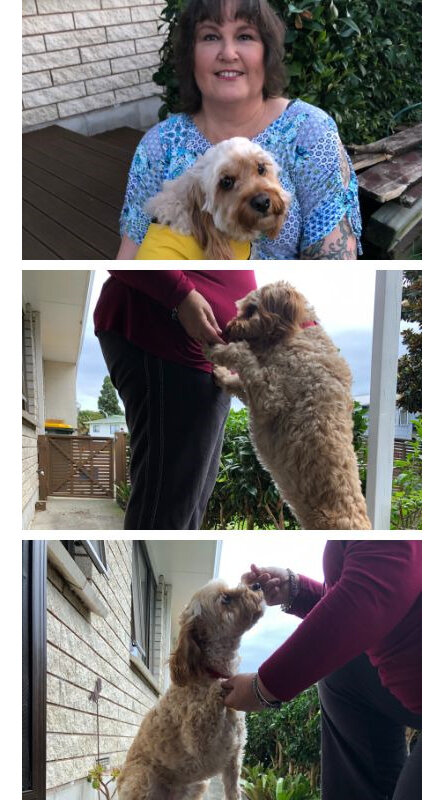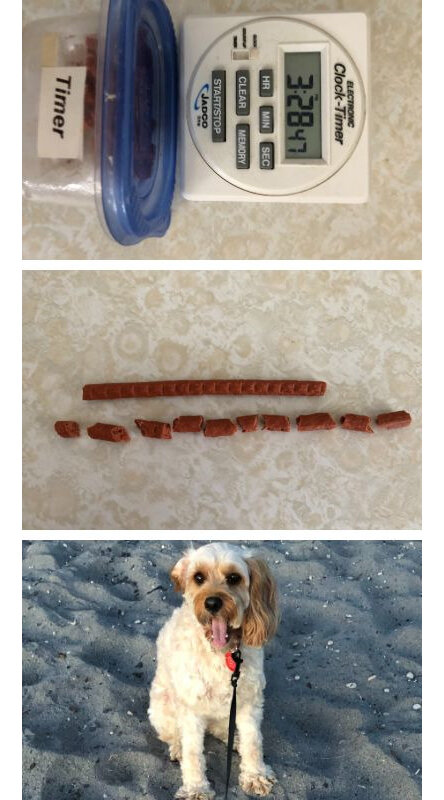Franklin Vets
Franklin Vets - excellence in veterinary care for dairy, farming, lifestyle, equine and household pets. BESTPRACTICE ACCREDITED NZ.

Not all recipients are deaf or know sign language so we are taught the same “signs’ that the dog has been taught. These are basically sit, heel, ‘where is it?’, and wait.
Meg is my second Hearing dog, I had Abbey from April 2013 – Jan 2021, and Meg from Feb 2021. I was hard of hearing and did not know sign language, I went deaf in Oct 2021, and have since taken sign language classes to learn some basic signs. Abbey was a Shitz Tzu X King Charles, Meg is a Cavoodle.
The best way to train a dog (or even a child) is with rewards. The reward can be both positive praise and a doggy treat. We cut treats into small pieces (e.g. Vitapet Jerhigh dog treats chicken sticks), the reason we cut them up is because we do not want to over-feed the dog. 1 stick is cut into pieces about finger width.
I have small containers with treats:
The phone alert is probably the hardest for the dogs to learn, so we break it up into smaller sections as we want the dog to succeed. They are rewarded with pats, verbal praise and a couple of treats when they do each step.
Step 1. Hold dog, and show them the treat container (rattle it) by the phone. Let go of dog when the phone rings so they run to phone. (get a treat) They learn that phone ringing sound = treat.
Step 2. Ring phone, dog runs to phone (no treat) and person sitting in the same room, then shows them the treat to encourage the dog to go to them. We teach them to alert by pulling the treat back slowly so they have to rise up and put their front paws on the person’s knees. This is alerting. Treat is with the person they have to alert.
Step 3. Run to phone, run to person\alert and go back to phone. Initially, there may be a treat at ‘alert’ and treats at the phone. Treat is back by telephone as this is the final stop.
Step 4. The person to be alerted goes to another room so the dog has to find them when the phone starts ringing. The treat container is by the phone and this is where it lives. Eventually, the dog will alert you from anywhere in the house or outside.
If you make it fun and pleasant for the dog, they will think it is a game and want to please their owner and get treats. Some dogs will pick up tricks easily, others take more time. Dogs, like humans, have ‘off days’, so if practising is not going well, stop and try tomorrow.
It is important that during training, those involved are all positive, enthusiastic and verbal. The better the positive feedback the quicker the dog will respond\learn.
We let the dog know that we are going to ‘practice’ sound work by using a squeaker to get them to find us. We go to a different room, with a couple of treats in our hand, and start squeaking the squeaker. They will run to find you knowing there will be treats. Again we hold the treats at waist height (lower for smaller dogs) to encourage them to put their front paws on our leg, holding them there by slowly giving them the treats.
I do not believe this is a specific ‘training method’. If you were to give it a name it would be positive reinforcement.
When Meg alerts me, I ask her “Where is it” and do the NZSL sign for where
I then follow her to the ‘sound’ she is alerting me to e.g. phone, front door (door-bell) or the timer going off. When we reach the location of ‘where’ she is instructed to sit: This is NZSL for sit. Our dogs are taught a different signal for sit – which originated from our trainer who was a UK Military dog trainer. The sign is a rotation upwards of your right hand, when holding your arm at waist height. I taught Abbey and Meg to sit at either sign. Most times I do not even need to say “sit”.

THE IMPORTANT BIT – this is the reward. Treat containers are handy so while the sound is still happening, you quickly remove a couple of treats and give to the dog while telling her\him what a good girl/boy she is, using a bright, happy voice. Then you answer the phone, open the door, or turn off the timer.
The same timer that I use in the lounge/kitchen is my morning alarm. When it goes off in the morning, Meg jumps up onto the bed to wake me up – often there are doggy kisses involved. Once I am awake – before turning off the timer, she gets a couple of treats & then I turn the timer off.
The big exception is the smoke detector – the dog will ‘alert’ and then go down flat on its tummy.
*the other ‘sign’ they are taught is ‘find Mum’, this is a sweeping upwards gesture with your arm while giving the verbal command to ‘find mum’. The dog will race off and find ‘Mum’, alert her and take her to whoever gave the signal. This was especially helpful when my kids were young and I could not hear them calling for me, they called Abbey and sent her to find me. Again, treats would be given for a job well done.
Start small! Have the dog ‘sit’, verbal command to ‘stay’. I also use the NZSL ‘stop’
I hold my hand in the ‘stop’ position, but at waist height – which is closer to the dog. Then I walk a short distance from the dog. Turn and face the dog and call them to you, and give verbal rewards\treats. If they have not waited, you take them back to sit and start again.
Gradually increase the distance you go from the dog, you can do this outside or inside by moving to another room.
Our Hearing Dogs must do a recall of 100m, so we go to the local rugby field and I instruct Meg to sit\wait. I then walk about 1/3 the length of the field, turn and call her to me and reward with treats.
I have taught both my dogs to walk with me off lead. When they are ‘working (wearing their coat in public)’ they are kept on a short lead to heel. So if I am walking Meg she is roaming at will with me. It makes her look like an untrained dog, but the walk is fun\play time for her.
I took treats with me on walks when they were on their lead. Periodically during the walk I would stop & recall the dog to me, giving it a treat or two for coming back to me. I used a similar system to teach them to ‘wait’ – a verbal command when walking, which I use when we wish to cross a road. Meg will not cross a road without me to tell her to ‘cross’. As she approaches the end of the footpath I verbally command her to ‘wait’, she waits for me, I check the way is clear, and give the ‘cross’ command. Initially, I waved my hand forward, but she has it now so I just say ‘cross’.
I have 2 children, for 16 years (till I got Abbey) I did not sleep through the night. I could not hear the baby monitor, so if the kids were sick I slept on the floor by their bassinet or cot. I went from being the girl who wagged English class, so I did not have to give a 3-minute speech to being a Speaker for Hearing Dogs. I speak to groups from 5 up to a whole school.
I gained so much confidence with Abbey that I decided to study towards a Bachelor of Business, life happened and it was scaled down to a Diploma in Business and my graduation was 2021. Meg walked the stage with me as Abbey had passed.
As a divorced Mum of 2, I would wake up at night and not know why I was awake. Was it a noise? Was it one of the kids? So the independence, security and peace of mind from having Abbey\Meg is immense. Now that I am deaf, I can’t hear if someone comes up behind me at the shop\supermarket. But Meg will hear & smell them, she will turn to see who it is and I will feel the lead moving so will turn to look also.
She is an amazing conversation starter, I collect for several charities and we always do so well as everyone wants to come and say hello to Abbey/Meg.
**side note – Hearing Dogs are the only Disability Assist Dogs (there are 8 types in NZ) who are NOT working when in the public. They need to accompany us as if we leave them at home, we will not be there for them to alert, and they will stop alerting – but we don’t know they have stopped as we do not hear the sound. They are also a visible identification of an invisible disability.
While I was a Massey (Albany), thousands of students knew Abbey’s name – and would greet her in the hallways. I was just “Abbey’s Mum”
I had Meg for 8 months when I went deaf, which was a shattering experience for me added to the fact that I had been made redundant the month before. Everyone was wearing masks and I needed to lip-read to know what was being said. Without Meg, I would have been truly lost. She has been an incredible help as I work with my anxiety and depression.
Meg is brushed each morning after our walk. She initially did not like the brush, so I encouraged her with treats. This eventually became a trick when I finished brushing her I would ask for her paw, which she would place in my hand. I would give her a couple of treats, I then close the treat container. I say ‘boop’ and she rises up to boop my nose with hers. I give her the final treat and then she puts both paws on my left shoulder and we have a quick hug. Then she hops down all excited as she knows breakfast is next.
Thanks for reading - Helen & Meg